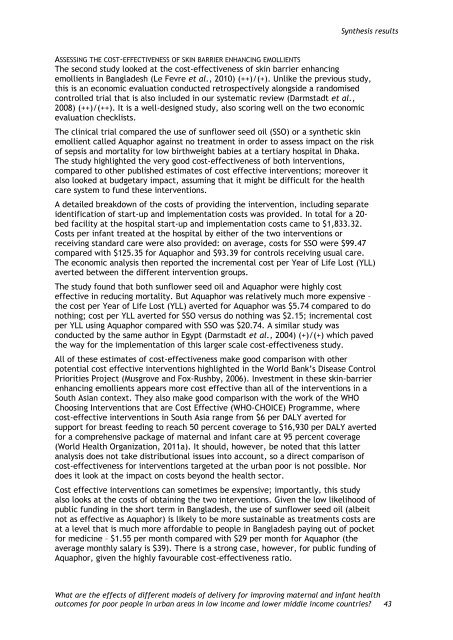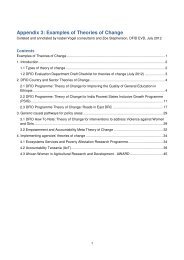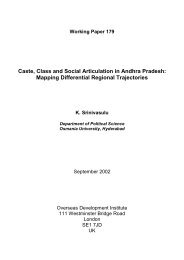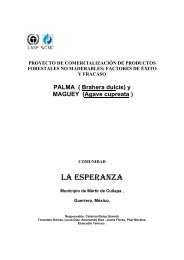Full Report - Research for Development - Department for ...
Full Report - Research for Development - Department for ...
Full Report - Research for Development - Department for ...
Create successful ePaper yourself
Turn your PDF publications into a flip-book with our unique Google optimized e-Paper software.
Synthesis results<br />
ASSESSING THE COST-EFFECTIVENESS OF SKIN BARRIER ENHANCING EMOLLIENTS<br />
The second study looked at the cost-effectiveness of skin barrier enhancing<br />
emollients in Bangladesh (Le Fevre et al., 2010) (++)/(+). Unlike the previous study,<br />
this is an economic evaluation conducted retrospectively alongside a randomised<br />
controlled trial that is also included in our systematic review (Darmstadt et al.,<br />
2008) (++)/(++). It is a well-designed study, also scoring well on the two economic<br />
evaluation checklists.<br />
The clinical trial compared the use of sunflower seed oil (SSO) or a synthetic skin<br />
emollient called Aquaphor against no treatment in order to assess impact on the risk<br />
of sepsis and mortality <strong>for</strong> low birthweight babies at a tertiary hospital in Dhaka.<br />
The study highlighted the very good cost-effectiveness of both interventions,<br />
compared to other published estimates of cost effective interventions; moreover it<br />
also looked at budgetary impact, assuming that it might be difficult <strong>for</strong> the health<br />
care system to fund these interventions.<br />
A detailed breakdown of the costs of providing the intervention, including separate<br />
identification of start-up and implementation costs was provided. In total <strong>for</strong> a 20bed<br />
facility at the hospital start-up and implementation costs came to $1,833.32.<br />
Costs per infant treated at the hospital by either of the two interventions or<br />
receiving standard care were also provided: on average, costs <strong>for</strong> SSO were $99.47<br />
compared with $125.35 <strong>for</strong> Aquaphor and $93.39 <strong>for</strong> controls receiving usual care.<br />
The economic analysis then reported the incremental cost per Year of Life Lost (YLL)<br />
averted between the different intervention groups.<br />
The study found that both sunflower seed oil and Aquaphor were highly cost<br />
effective in reducing mortality. But Aquaphor was relatively much more expensive –<br />
the cost per Year of Life Lost (YLL) averted <strong>for</strong> Aquaphor was $5.74 compared to do<br />
nothing; cost per YLL averted <strong>for</strong> SSO versus do nothing was $2.15; incremental cost<br />
per YLL using Aquaphor compared with SSO was $20.74. A similar study was<br />
conducted by the same author in Egypt (Darmstadt et al., 2004) (+)/(+) which paved<br />
the way <strong>for</strong> the implementation of this larger scale cost-effectiveness study.<br />
All of these estimates of cost-effectiveness make good comparison with other<br />
potential cost effective interventions highlighted in the World Bank’s Disease Control<br />
Priorities Project (Musgrove and Fox-Rushby, 2006). Investment in these skin-barrier<br />
enhancing emollients appears more cost effective than all of the interventions in a<br />
South Asian context. They also make good comparison with the work of the WHO<br />
Choosing Interventions that are Cost Effective (WHO-CHOICE) Programme, where<br />
cost-effective interventions in South Asia range from $6 per DALY averted <strong>for</strong><br />
support <strong>for</strong> breast feeding to reach 50 percent coverage to $16,930 per DALY averted<br />
<strong>for</strong> a comprehensive package of maternal and infant care at 95 percent coverage<br />
(World Health Organization, 2011a). It should, however, be noted that this latter<br />
analysis does not take distributional issues into account, so a direct comparison of<br />
cost-effectiveness <strong>for</strong> interventions targeted at the urban poor is not possible. Nor<br />
does it look at the impact on costs beyond the health sector.<br />
Cost effective interventions can sometimes be expensive; importantly, this study<br />
also looks at the costs of obtaining the two interventions. Given the low likelihood of<br />
public funding in the short term in Bangladesh, the use of sunflower seed oil (albeit<br />
not as effective as Aquaphor) is likely to be more sustainable as treatments costs are<br />
at a level that is much more af<strong>for</strong>dable to people in Bangladesh paying out of pocket<br />
<strong>for</strong> medicine – $1.55 per month compared with $29 per month <strong>for</strong> Aquaphor (the<br />
average monthly salary is $39). There is a strong case, however, <strong>for</strong> public funding of<br />
Aquaphor, given the highly favourable cost-effectiveness ratio.<br />
What are the effects of different models of delivery <strong>for</strong> improving maternal and infant health<br />
outcomes <strong>for</strong> poor people in urban areas in low income and lower middle income countries? 43









